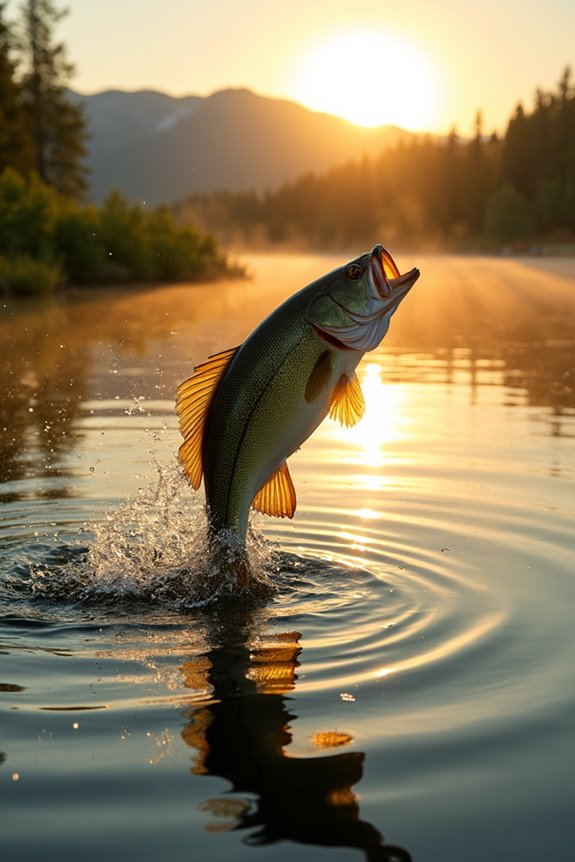Fish jump out of water for various reasons. During spawning, males show off behavior and colors to attract females. They also jump to escape predators, using powerful thrusts to evade capture. Poor water quality can stress fish, prompting them to leap as a response. To improve your catch, use topwater lures during spawning or when fish are active due to insects. Monitoring water conditions will help optimize your fishing strategy. Discover more insights about fish behavior and effective techniques.
Key Takeaways
- Fish jump to escape predators, using sudden movements to disrupt pursuit and enhance survival chances.
- During spawning, males exhibit jumping behaviors to assert dominance and attract females.
- Water quality impacts fish behavior; jumping may indicate stress from low oxygen or toxic conditions.
- Fish also jump while foraging to surprise prey, especially during insect hatches, improving their hunting success.
- Habitat fragmentation affects migratory patterns, leading fish to jump as they navigate through altered environments.
Reproductive Behavior and Spawning
When fish approach their spawning season, they often migrate to specific inshore habitats that provide ideal conditions for their eggs and larvae. During this time, I’ve noticed that many species engage in fascinating mating rituals. Males display unique swimming patterns and vibrant color changes to attract females. As they gather in traditional spawning grounds, territorial disputes can arise, with larger males aggressively defending their chosen spots. This behavior is essential for ensuring access to best spawning sites. I’ve observed that during these interactions, fish often jump, either to assert dominance or as part of their elaborate courtship displays. Using topwater lures effectively during these periods can dramatically increase catch rates as fish are already in an aggressive, territorial state. Understanding these patterns can greatly enhance your fishing experience, especially when targeting species during their spawning season.
Environmental Stress and Water Quality
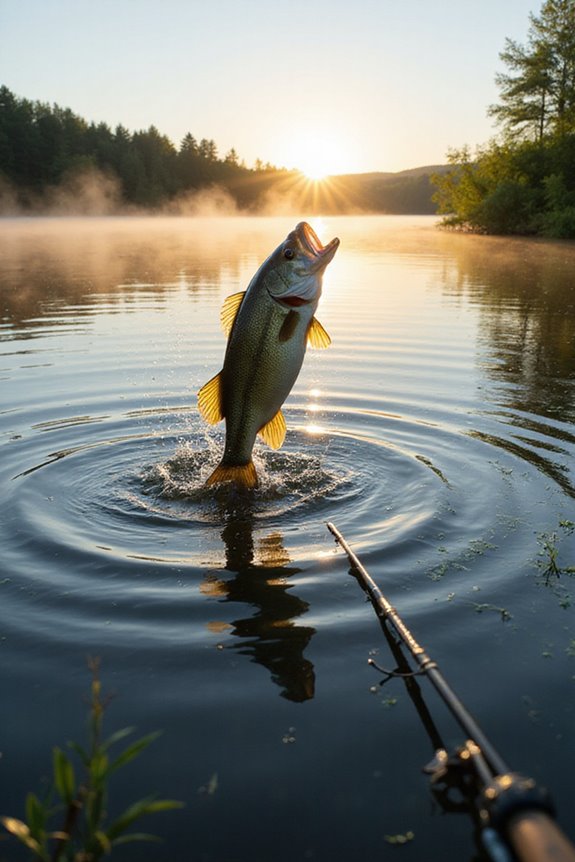
Fish are highly sensitive to their environment, and factors like water quality can greatly impact their behavior, including jumping. Oxygen depletion often occurs in stagnant waters or overcrowded tanks, leading to respiratory distress. When fish struggle to breathe, they jump in search of more oxygen-rich areas. Additionally, water toxicity from high ammonia and nitrite levels can irritate their gills, making them more prone to escaping by leaping. To combat these issues, I recommend using aeration devices to enhance oxygen levels and regularly testing water quality with reliable kits. Maintaining a proper filtration system and avoiding overfeeding can prevent toxic buildup, ensuring a healthier environment for your fish and reducing their jumping behavior. For extended absences, consider installing an automatic fish feeder that provides consistent feeding schedules to prevent stress from irregular mealtimes.
Escape From Predators
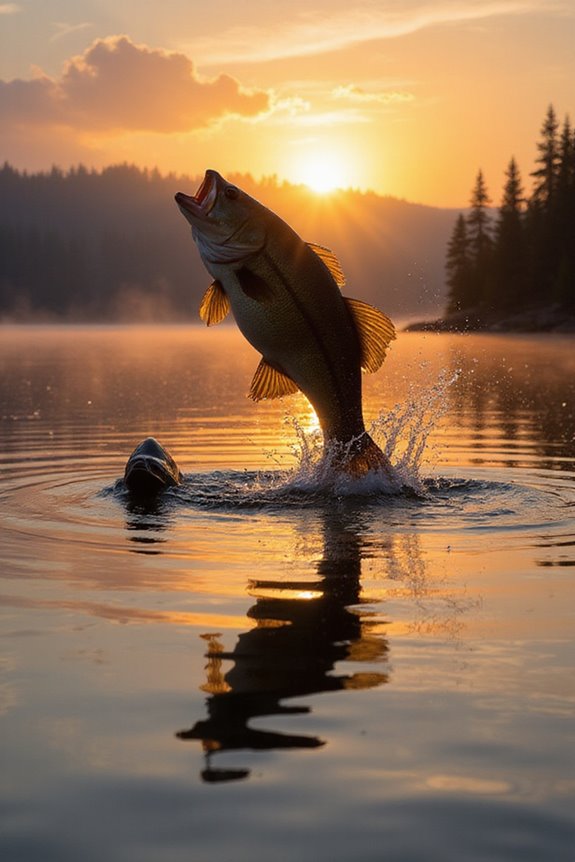
Understanding how fish escape from predators is essential for both enthusiasts and researchers alike. Fish utilize predator detection through specialized sensory systems, like the lateral line, to sense water movements made by approaching threats. When they perceive danger, their neural circuits activate, triggering escape strategies. Initially, they bend their head and tail, building up tension. This leads to a powerful thrust, allowing them to leap out of the water and gain distance from predators. This dramatic escape not only disrupts the predator’s pursuit but also increases survival chances. Observing these behaviors in different environments can enhance your fishing techniques. By understanding the mechanics behind their escape, you can better anticipate fish movements, improving your success on the water. Fish are typically more active during stable pressure periods, which can influence when they’re most likely to display jumping behaviors.
Foraging and Hunting Strategies
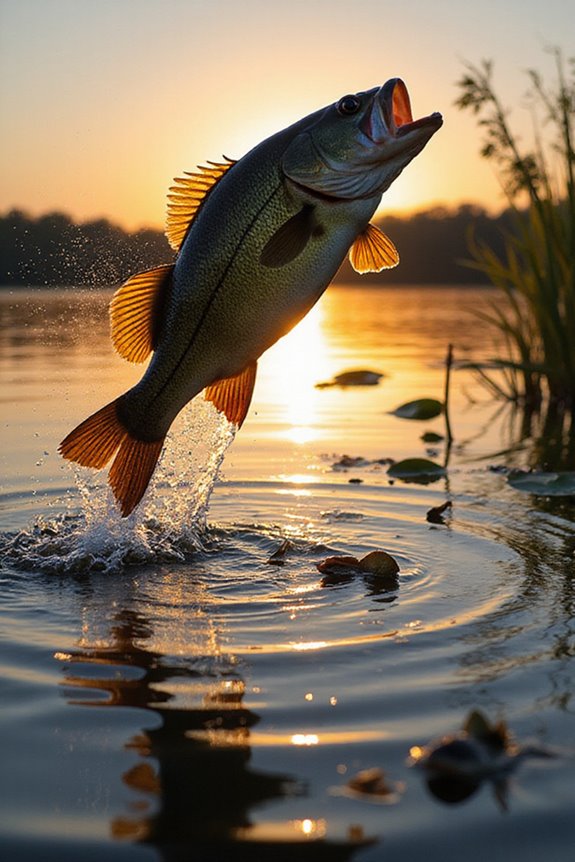
For anglers seeking to improve their success, recognizing the foraging and hunting strategies of fish can be a game changer. Fish often jump to enhance prey capture, surprising insects and other arthropods from above the water’s surface. This behavior markedly boosts their hunting strategies, particularly when targeting evasive prey. Using high jumps, fish can quickly close the gap on fleeing targets, especially during seasonal insect hatches when food is abundant. To improve your chances, fish during times of increased surface activity and consider using lures that mimic aerial prey. Observing fish behavior, such as jumping efficiency and feeding behavior, allows you to adapt your tactics, maximizing your success in catching these agile predators.
Habitat Exploration and Migration
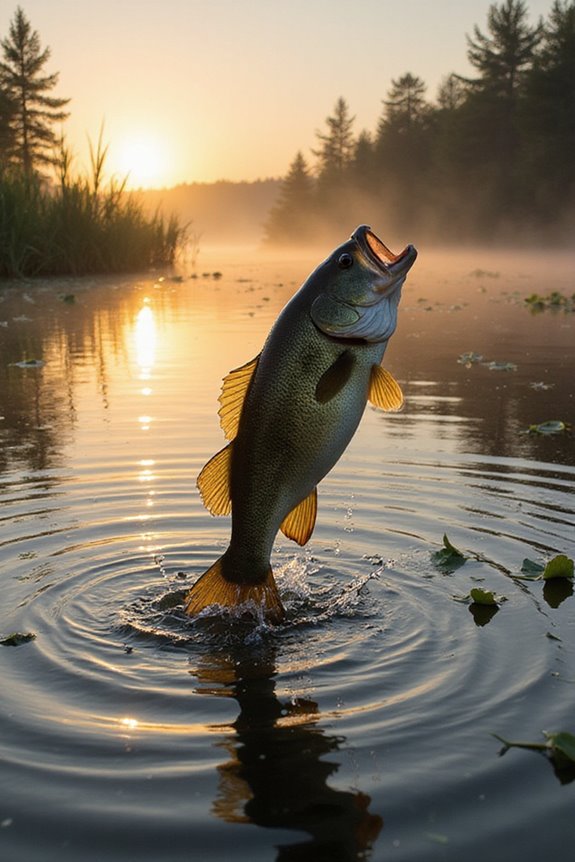
When exploring the habitat and migration patterns of fish, it is vital to recognize how these factors influence your fishing success. Habitat fragmentation, caused by barriers like dams, disrupts migratory patterns, making it essential to know where fish can access spawning grounds. Focus on tributaries with favorable conditions, as they often attract fish during their annual migrations. Use a sonar fish finder to locate schools and monitor water temperatures, which can signal when fish are on the move. Target areas near natural habitats that have been restored, as these spots will likely yield better results. Understanding these patterns enhances your strategy and ultimately increases your chances of a successful catch.
Mechanical and Behavioral Aspects of Jumping
Fish jumping behavior is a fascinating aspect of their mechanics and adaptations that can profoundly influence your fishing strategy. Understanding jump mechanics is essential. For instance, fish like guppies swim backward to build momentum before launching into the air. This preparatory phase often involves precise fin coordination, where multiple fins work together to achieve maximum thrust. When fishing, pay attention to jumping activity; it might indicate fish trying to escape predators or hunt prey above the surface. Use lures that mimic distressed prey to capitalize on this behavior. Locations near structures where fish might leap can be particularly productive. By recognizing these patterns and employing the right techniques, you can increase your chances of a successful catch.
Frequently Asked Questions
Do All Fish Species Jump, or Is It Specific to Certain Types?
Not all fish species jump; it really depends on species variety. I’ve noticed that jumping frequency varies considerably among predators and invasive species, while more sedentary fish typically don’t engage in this behavior at all.
How Does Water Temperature Affect Fish Jumping Behavior?
Water temperature markedly influences fish metabolism, affecting their energy levels and stress responses. I’ve observed that warmer waters often lead to increased jumping behavior, likely as a response to heightened activity and discomfort.
Can Fish Jump Out of Water During the Night?
Absolutely, fish can jump out of water at night! I’ve noticed that their nighttime activity often relates to environmental factors or stress, showcasing their fascinating nocturnal behavior, even when we can’t easily observe it.
Is Jumping Behavior Different in Freshwater Versus Saltwater Fish?
Did you know freshwater fish can jump up to 10 feet high? I find it fascinating that freshwater fish jump more frequently than saltwater fish, often for spawning or escaping predators, highlighting their unique behavioral adaptations.
What Role Does Fish Size Play in Jumping Ability?
I’ve noticed that fish size plays a vital role in jump height. Heavier fish often jump higher in absolute terms, but lighter fish can leap more proportionally, showcasing fascinating adaptations based on their weight and body structure.

